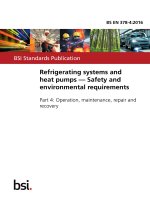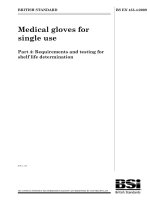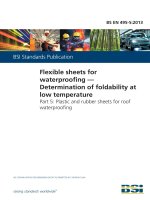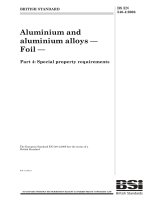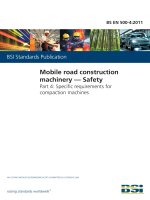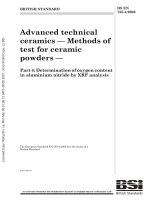Bsi bs en 61400 4 2013
Bạn đang xem bản rút gọn của tài liệu. Xem và tải ngay bản đầy đủ của tài liệu tại đây (4.32 MB, 162 trang )
BS EN 61400-4:2013
BSI Standards Publication
Wind turbines
Part 4: Design requirements for
wind turbine gearboxes
NO COPYING WITHOUT BSI PERMISSION EXCEPT AS PERMITTED BY COPYRIGHT LAW
raising standards worldwide™
BS EN 61400-4:2013 BRITISH STANDARD
National foreword
This British Standard is the UK implementation of EN 61400-4:2013.
It is identical to IEC 61400-4:2012. It supersedes BS ISO 81400-4:2005,
which is withdrawn.
The UK participation in its preparation was entrusted by
Technical Committee PEL/88, Wind turbines, to Panel PEL/88/-/4,
Wind turbine gearboxes (JWG 1).
A list of organizations represented on this committee can be
obtained on request to its secretary.
This publication does not purport to include all the necessary provisions
of a contract. Users are responsible for its correct application.
© The British Standards Institution 2013.
Published by BSI Standards Limited 2013.
ISBN 978 0 580 69337 3
ICS 21.200; 27.180
Compliance with a British Standard cannot confer immunity
from legal obligations.
This British Standard was published under the authority of the
Standards Policy and Strategy Committee on 30 April 2013.
Amendments issued since publication
Date Text affected
EUROPEAN STANDARD BS EN 61400-4:2013
NORME EUROPÉENNE
EUROPÄISCHE NORM EN 61400-4
ICS 27.180 March 2013
English version
Wind turbines -
Part 4: Design requirements for wind turbine gearboxes
(IEC 61400-4:2012)
Eoliennes - Windenergieanlagen -
Partie 4: Exigences de conception des Teil 4: Auslegungsanforderungen für
btes de vitesses pour éoliennes Getriebe von Windenergieanlagen
(CEI 61400-4:2012) (IEC 61400-4:2012)
This European Standard was approved by CENELEC on 2013-01-08. CENELEC members are bound to comply
with the CEN/CENELEC Internal Regulations which stipulate the conditions for giving this European Standard
the status of a national standard without any alteration.
Up-to-date lists and bibliographical references concerning such national standards may be obtained on
application to the CEN-CENELEC Management Centre or to any CENELEC member.
This European Standard exists in three official versions (English, French, German). A version in any other
language made by translation under the responsibility of a CENELEC member into its own language and notified
to the CEN-CENELEC Management Centre has the same status as the official versions.
CENELEC members are the national electrotechnical committees of Austria, Belgium, Bulgaria, Croatia, Cyprus,
the Czech Republic, Denmark, Estonia, Finland, Former Yugoslav Republic of Macedonia, France, Germany,
Greece, Hungary, Iceland, Ireland, Italy, Latvia, Lithuania, Luxembourg, Malta, the Netherlands, Norway, Poland,
Portugal, Romania, Slovakia, Slovenia, Spain, Sweden, Switzerland, Turkey and the United Kingdom.
CENELEC European Committee for Electrotechnical Standardization
Comité Européen de Normalisation Electrotechnique
Europäisches Komitee für Elektrotechnische Normung
Management Centre: Avenue Marnix 17, B - 1000 Brussels
© 2013 CENELEC - All rights of exploitation in any form and by any means reserved worldwide for CENELEC members.
Ref. No. EN 61400-4:2013 E
BS EN 61400-4:2013
EN 61400-4:2013
Foreword
The text of document 88/438/FDIS, future edition 1 of IEC 61400-4, prepared by IEC/TC 88 "Wind
turbines" and ISO/TC 60 "Gears" was submitted to the IEC-CENELEC parallel vote and approved by
CENELEC as EN 61400-4:2013.
The following dates are fixed: (dop) 2013-10-08
(dow) 2016-01-08
• latest date by which the document has
to be implemented at national level by
publication of an identical national
standard or by endorsement
• latest date by which the national
standards conflicting with the
document have to be withdrawn
Attention is drawn to the possibility that some of the elements of this document may be the subject of
patent rights. CENELEC [and/or CEN] shall not be held responsible for identifying any or all such patent
rights.
Endorsement notice
The text of the International Standard IEC 61400-4:2012 was approved by CENELEC as a European
Standard without any modification.
In the official version, for Bibliography, the following notes have to be added for the standards indicated:
ISO/IEC 17025 NOTE Harmonized as EN ISO/IEC 17025.
ISO 2160 NOTE Harmonized as EN ISO 2160.
BS EN 61400-4:2013
EN 61400-4:2013
Annex ZA
(normative)
Normative references to international publications
with their corresponding European publications
The following documents, in whole or in part, are normatively referenced in this document and are
indispensable for its application. For dated references, only the edition cited applies. For undated
references, the latest edition of the referenced document (including any amendments) applies.
NOTE When an international publication has been modified by common modifications, indicated by (mod), the relevant EN/HD
applies.
Publication Year Title EN/HD Year
IEC 60050 series -
IEC 61400-1 2005 International electrotechnical vocabulary - 2005
IEC 61400-3 - -
Wind turbines - EN 61400-1
IEC/TS 61400-13 2001 Part 1: Design requirements -
IEC 61400-22 2010 2011
ISO 76 - Wind turbines - EN 61400-3 -
ISO 281 2007 -
ISO 683 series Part 3: Design requirements for offshore wind -
ISO 1328-1 - -
turbines
ISO 4287 - -
Wind turbine generator systems - -
ISO 4288 - -
Part 13: Measurement of mechanical loads
ISO 4406 - -
Wind turbines - EN 61400-22
ISO 5725-2 - Part 22: Conformity testing and certification -
ISO 6336 series Rolling bearings - Static load ratings - -
ISO 6336-1 2006 -
Rolling bearings - Dynamic load ratings and -
rating life
Heat-treatable steels, alloy steels and free- -
cutting steels
Cylindrical gears - ISO system of accuracy - -
Part 1: Definitions and allowable values of
deviations relevant to corresponding flanks of
gear teeth
Geometrical Product Specifications (GPS) - EN ISO 4287
Surface texture: Profile method - Terms,
definitions and surface texture parameters
Geometrical Product Specifications (GPS) - EN ISO 4288
Surface texture: Profile method - Rules and
procedures for the assessment of surface
texture
Hydraulic fluid power - Fluids - Method for -
coding the level of contamination by solid
particles
Accuracy (trueness and precision) of -
measurement methods and results -
Part 2: Basic method for the determination of
repeatability and reproducibility of a standard
measurement method
Calculation of load capacity of spur and helical-
gears
Calculation of load capacity of spur and helical-
gears -
Part 1: Basic principles, introduction and
general influence factors
BS EN 61400-4:2013
EN 61400-4:2013
Publication Year Title EN/HD Year
ISO 6336-2 2006 -
Calculation of load capacity of spur and helical-
gears - -
Part 2: Calculation of surface durability -
(pitting) -
ISO 6336-3 2006 Calculation of load capacity of spur and helical- -
ISO 6336-5 2003 gears -
ISO 6336-6 2006 Part 3: Calculation of tooth bending strength -
Calculation of load capacity of spur and helical- -
gears - -
Part 5: Strength and quality of materials -
-
Calculation of load capacity of spur and helical- -
gears - -
Part 6: Calculation of service life under -
variable load -
-
ISO/TR 10064-3 - Code of inspection practice - - -
-
Part 3: Recommendations relative to gear -
-
blanks, shaft centre distance and parallelism
of axes
ISO 12925-1 - Lubricants, industrial oils and related products -
(class L) - Family C (Gears) -
Part 1: Specifications for lubricants for
enclosed gear systems
ISO/TR 13593 - Enclosed gear drives for industrial -
applications
ISO/TR 13989-1 - Calculation of scuffing load capacity of -
cylindrical, bevel and hypoid gears -
Part 1: Flash temperature method Hide details
ISO/TR 13989-2 - Calculation of scuffing load capacity of -
cylindrical, bevel and hypoid gears -
Part 2: Integral temperature method
ISO 14104 - Gears - Surface temper etch inspection after -
ISO 14635-1 2000 grinding
Gears - FZG test procedures - -
Part 1: FZG test method A/8,3/90 for relative
scuffing load-carrying capacity of oils
ISO 15243 2004 Rolling bearings - Damage and failures - -
ISO/TS 16281 2008
Terms, characteristics and causes
Rolling bearings - Methods for calculating the -
modified reference rating life for universally
loaded bearings
AGMA 9005 - Industrial Gear Lubrication -
ANSI/AGMA 925- - Effect of lubrication on gear surface distress -
A02
ANSI/AGMA 6001- - Design and selection of components for -
E10
enclosed gear drives
ANSI/AGMA 6123 - Design manual for enclosed epicyclic gear -
drives
ASTM E1049-85 - Standard practices for cycle counting in -
fatigue analysis
DIN 471 - Circlips (retaining rings) for shafts: Normal -
type and heavy type
BS EN 61400-4:2013
EN 61400-4:2013
Publication Year Title EN/HD Year
DIN 472 - -
DIN 743 2000 Circlips (retaining rings) for bores: Normal - -
DIN 3990-4 - type and heavy type -
DIN 6885-2 - -
DIN 6892 - Shafts and axles, calculations of load - -
DIN 7190 - -
DIN 51517-3 - capacity, Parts 1,2, 3 -
- - Calculation of load capacity of cylindrical - 2003
gears: calculation of scuffing load capacity
Parallel Key Geometries -
Mitnehmerverbindungen ohne Anzug – -
Passfedern – Berechnung und Gestaltung
Interference fits – Calculation and design rules-
Lubricants: Lubricating oils – -
Part 3: Lubricating oils CLP; Minimum
requirements
Founding - Ultrasonic examination - EN 12680-3
Part 3: Spheroidal graphite cast iron castings
BS EN 61400-4:2013
61400-4 © IEC:2012(E)
CONTENTS
INTRODUCTION . ..................................................................................................................................9
1 Scope . ........................................................................................................................................... 10
2 Normative references . ................................................................................................................10
3 Terms, definitions and conventions...........................................................................................12
3.1 Terms and definitions . ......................................................................................................12
3.2 Conventions .......................................................................................................................15
4 Symbols, abbreviations and units .............................................................................................17
4.1 Symbols and units .............................................................................................................17
4.2 Abbreviations . ...................................................................................................................21
5 Design for reliability. ...................................................................................................................23
5.1 Design lifetime and reliability ...........................................................................................23
5.2 Design process . ................................................................................................................24
5.3 Documentation . .................................................................................................................26
5.4 Quality plan ........................................................................................................................26
6 Drivetrain operating conditions and loads . ..............................................................................27
6.1 Drivetrain description . ......................................................................................................27
6.1.1 General . ................................................................................................................27
6.1.2 Interface definition . ..............................................................................................27
6.1.3 Specified requirements across interfaces.........................................................28
6.2 Deriving drivetrain loads . .................................................................................................28
6.2.1 Wind turbine load simulation model ..................................................................28
6.2.2 Wind turbine load calculations ...........................................................................29
6.2.3 Reliability of load assumptions ..........................................................................29
6.3 Results from wind turbine load calculations ..................................................................29
6.3.1 General . ................................................................................................................29
6.3.2 Time series. ..........................................................................................................30
6.3.3 Fatigue load . ........................................................................................................30
6.3.4 Extreme loads ......................................................................................................31
6.4 Operating conditions . .......................................................................................................31
6.4.1 General . ................................................................................................................31
6.4.2 Environmental conditions ....................................................................................31
6.4.3 Operating strategies ............................................................................................32
6.5 Drivetrain analysis .............................................................................................................32
7 Gearbox design, rating, and manufacturing requirements . ...................................................32
7.1 Gearbox cooling . ...............................................................................................................32
7.2 Gears . ................................................................................................................................. 33
7.2.1 Gear reliability considerations. ...........................................................................33
7.2.2 Gear rating . ..........................................................................................................33
7.2.3 Load factors . ........................................................................................................34
7.2.4 Gear materials ......................................................................................................36
7.2.5 Subsurface initiated fatigue . ..............................................................................37
7.2.6 Gear accuracy ......................................................................................................37
7.2.7 Gear manufacturing .............................................................................................37
7.3 Bearings . ............................................................................................................................ 38
7.3.1 General . ................................................................................................................38
BS EN 61400-4:2013
61400-4 © IEC:2012(E)
7.3.2 Bearing reliability considerations . .....................................................................38
7.3.3 Bearing steel quality requirements . ...................................................................39
7.3.4 General design considerations...........................................................................39
7.3.5 Bearing interface requirements ..........................................................................42
7.3.6 Bearing design issues. ........................................................................................43
7.3.7 Bearing lubrication. ..............................................................................................46
7.3.8 Rating calculations . .............................................................................................47
7.4 Shafts, keys, housing joints, splines and fasteners . ....................................................50
7.4.1 Shafts . ...................................................................................................................50
7.4.2 Shaft-hub connections . .......................................................................................50
7.4.3 Flexible splines.....................................................................................................51
7.4.4 Shaft seals . ..........................................................................................................51
7.4.5 Fasteners ..............................................................................................................51
7.4.6 Circlips (snap rings).............................................................................................52
7.5 Structural elements . .........................................................................................................52
7.5.1 Introduction . .........................................................................................................52
7.5.2 Reliability considerations ....................................................................................53
7.5.3 Deflection analysis . .............................................................................................53
7.5.4 Strength verification.............................................................................................53
7.5.5 Static strength assessment . ...............................................................................54
7.5.6 Fatigue strength assessment . ............................................................................58
7.5.7 Material tests . .......................................................................................................62
7.5.8 Documentation .....................................................................................................63
7.6 Lubrication . ........................................................................................................................63
7.6.1 General considerations . ......................................................................................63
7.6.2 Type of lubricant. .................................................................................................64
7.6.3 Lubricant characteristics . ....................................................................................65
7.6.4 Method of lubrication ...........................................................................................66
7.6.5 Oil quantity . ..........................................................................................................67
7.6.6 Operating temperatures . .....................................................................................68
7.6.7 Temperature control ............................................................................................68
7.6.8 Lubricant condition monitoring ...........................................................................69
7.6.9 Lubricant cleanliness ...........................................................................................69
7.6.10 Lubricant filter ......................................................................................................70
7.6.11 Ports ......................................................................................................................71
7.6.12 Oil level indicator . ................................................................................................71
7.6.13 Magnetic plugs .....................................................................................................71
7.6.14 Breather . ...............................................................................................................72
7.6.15 Flow sensor . .........................................................................................................72
7.6.16 Serviceability . .......................................................................................................72
8 Design verification .......................................................................................................................72
8.1 General ............................................................................................................................... 72
8.2 Test planning . ...................................................................................................................72
8.2.1 Identifying test criteria . .......................................................................................72
8.2.2 New designs or substantive changes ................................................................73
8.2.3 Overall test plan . .................................................................................................73
8.2.4 Specific test plans . ..............................................................................................73
8.3 Workshop prototype testing .............................................................................................74
8.3.1 General . ................................................................................................................74
BS EN 61400-4:2013
61400-4 © IEC:2012(E)
8.3.2 Component testing . .............................................................................................74
8.3.3 Workshop testing of a prototype gearbox .........................................................74
8.3.4 Lubrication system testing ..................................................................................75
8.4 Field test . ...........................................................................................................................75
8.4.1 General . ................................................................................................................75
8.4.2 Validation of loads . ..............................................................................................75
8.4.3 Type test of gearbox in wind turbine .................................................................76
8.5 Production testing .............................................................................................................77
8.5.1 Acceptance testing . .............................................................................................77
8.5.2 Sound emission testing. ......................................................................................77
8.5.3 Vibration testing . .................................................................................................77
8.5.4 Lubrication system considerations . ...................................................................77
8.5.5 System temperatures ...........................................................................................77
8.6 Robustness test . ...............................................................................................................77
8.7 Field lubricant temperature and cleanliness ..................................................................77
8.8 Bearing specific validation . ..............................................................................................78
8.8.1 Design reviews .....................................................................................................78
8.8.2 Prototype verification/validation .........................................................................78
8.9 Test documentation . .........................................................................................................79
9 Operation, service and maintenance requirements ................................................................79
9.1 Service and maintenance requirements .........................................................................79
9.2 Inspection requirements . .................................................................................................79
9.3 Commissioning and run-in . ..............................................................................................79
9.4 Transport, handling and storage . ....................................................................................80
9.5 Repair ................................................................................................................................. 80
9.6 Installation and exchange . ...............................................................................................80
9.7 Condition monitoring . .......................................................................................................80
9.8 Lubrication . ........................................................................................................................80
9.8.1 Oil type requirements . ........................................................................................80
9.8.2 Lubrication system. ..............................................................................................80
9.8.3 Oil test and analysis ............................................................................................81
9.9 Operations and maintenance documentation ................................................................81
Annex A (informative) Examples of drivetrain interfaces and loads specifications . ................82
Annex B (informative) Gearbox design and manufacturing considerations ...............................93
Annex C (informative) Bearing design considerations .................................................................96
Annex D (informative) Considerations for gearbox structural elements . ................................. 122
Annex E (informative) Recommendations for lubricant performance in wind turbine
gearboxes .......................................................................................................................................... 125
Annex F (informative) Design verification documentation ......................................................... 140
Annex G (informative) Bearing calculation documentation ........................................................ 143
Bibliography. ..................................................................................................................................... 151
Figure 1 – Shaft designation in 3-stage parallel shaft gearboxes................................................15
Figure 2 – Shaft designation in 3-stage gearboxes with one planet stage. ................................16
Figure 3 – Shaft designation in 3-stage gearboxes with two planet stages ...............................17
Figure 4 – Design process flow chart . .............................................................................................25
Figure 5 – Examples of bearing selection criteria ..........................................................................39
BS EN 61400-4:2013
61400-4 © IEC:2012(E)
Figure 6 – Blind bearing assembly . .................................................................................................45
Figure 7 – Definition of section factor npl,σ of a notched component . ........................................56
Figure 8 – Idealized elastic plastic stress-strain curve .................................................................57
Figure 9 – Synthetic S/N curve (adapted from Haibach, 2006) . ..................................................60
Figure A.1 – Modular drivetrain . .......................................................................................................82
Figure A.2 – Modular drivetrain with 3-point suspension . ............................................................83
Figure A.3 – Integrated drivetrain.....................................................................................................83
Figure A.4 – Reference system for modular drivetrain ..................................................................85
Figure A.5 – Rear view of drivetrain . ...............................................................................................86
Figure A.6 – Reference system for modular drivetrain with 3-point suspension . ......................87
Figure A.7 – Reference system for integrated drivetrain . .............................................................88
Figure A.8 – Example of rainflow counting per DLC . ....................................................................90
Figure A.9 – Example of load revolution distribution (LRD) .........................................................91
Figure C.1 – Load bin reduction by lumping neighbouring load bins . .........................................97
Figure C.2 – Consumed life index (CLI) . ........................................................................................99
Figure C.3 – Time share distribution . ..............................................................................................99
Figure C.4 – Effects of clearance and preload on pressure distribution in radial roller
bearings (from Brandlein et al, 1999) ............................................................................................ 102
Figure C.5 – Nomenclature for bearing curvature . ...................................................................... 103
Figure C.6 – Stress distribution over the elliptical contact area ................................................ 105
Figure C.7 – Examples of locating and non-locating bearing arrangements . .......................... 114
Figure C.8 – Examples of locating bearing arrangements. ......................................................... 114
Figure C.9 – Examples of accommodation of axial displacements . .......................................... 114
Figure C.10 – Examples of cross-locating bearing arrangements . ........................................... 115
Figure C.11 – Examples of bearing arrangements with paired mounting. ................................ 115
Figure D.1 – Locations of failure for local (A) and global (B) failure . ........................................ 123
Figure D.2 – Local and global failure for two different notch radii . ........................................... 123
Figure D.3 – Haigh-diagram for evaluation of mean stress influence (Haibach, 2006) . ........124
Figure E.1 – Viscosity requirements versus pitch line velocity . ................................................. 126
Figure E.2 – Test apparatus for filterability evaluation................................................................ 134
Figure E.3 – Example for circuit design of combined filtration and cooling system . ...............138
Table 1 – Symbols used in the document . ......................................................................................18
Table 2 – Abbreviations . ...................................................................................................................21
Table 3 – Mesh load factor Kγ for planetary stages . .....................................................................35
Table 4 – Required gear accuracy . .................................................................................................37
Table 5 – Temperature gradients for calculation of operating clearance . ..................................44
Table 6 – Bearing lubricant temperature for calculation of viscosity ratio, κ..............................46
Table 7 – Guide values for maximum contact stress at Miner’s sum dynamic
equivalent bearing load ......................................................................................................................49
Table 8 – Minimum safety factors for the different methods.........................................................50
Table 9 – Partial safety factors for materials ..................................................................................55
Table 10 – Partial safety factors γm for synthetic S/N-curves of cast iron materials . ...............61
Table 11 – Recommended cleanliness levels . ...............................................................................70
BS EN 61400-4:2013
61400-4 © IEC:2012(E)
Table A.1 – Drivetrain elements and local coordinate systems . ..................................................84
Table A.2 – Drivetrain element interface dimensions . ...................................................................85
Table A.3 – Interface requirements for modular drivetrain . ..........................................................86
Table A.4 – Interface requirements for modular drivetrain with 3-point suspension . ...............87
Table A.5 – Interface requirements for integrated drivetrain ........................................................88
Table A.6 – Engineering data and required design load descriptions . ........................................89
Table A.7 – Rainflow matrix example . .............................................................................................89
Table A.8 – Example of load duration distribution (LDD) . ............................................................91
Table A.9 – Extreme load matrix example . .....................................................................................92
Table B.1 – Recommended gear tooth surface roughness. ..........................................................94
Table C.1 – Guide values for basic rating life Lh10 for preliminary bearing selection .............96
Table C.2 – Static load factors for radial bearings . ..................................................................... 101
Table C.3 – Bearing types for combined loads with axial loads in double directions .............110
Table C.4 – Bearing types for combined loads with axial loads in single direction . ...............111
Table C.5 – Bearing types for pure radial load . ........................................................................... 112
Table C.6 – Bearing types for axial load. ...................................................................................... 113
Table C.7 – Bearing selection: Legend. ........................................................................................ 116
Table C.8 – Bearing selection: Low speed shaft (LSS) / planet carrier . .................................. 117
Table C.9 – Bearing selection: Low speed intermediate shaft (LSIS) ....................................... 118
Table C.10 – Bearing selection: High speed intermediate shaft (HSIS) . ................................. 119
Table C.11 – Bearing selection: High speed shaft (HSS). .......................................................... 120
Table C.12 – Bearing selection: Planet bearing ........................................................................... 121
Table D.1 – Typical material properties . ....................................................................................... 122
Table E.1 – Viscosity grade at operating temperature for oils with VI = 90 ............................. 127
Table E.2 – Viscosity grade at operating temperature for oils with VI = 120 . ......................... 128
Table E.3 – Viscosity grade at operating temperature for oils with VI = 160 . ......................... 129
Table E.4 – Viscosity grade at operating temperature for oils with VI = 240 . ......................... 130
Table E.5 – Standardized test methods for evaluating WT lubricants (fresh oil)..................... 132
Table E.6 – Non-standardized test methods for lubricant performance (fresh oil) . ................133
Table E.7– Guidelines for lubricant parameter limits .................................................................. 136
Table F.1 – Design validation and verification documentation . ................................................. 140
BS EN 61400-4:2013 – 9 –
61400-4 © IEC:2012(E)
INTRODUCTION
IEC 61400-4 outlines minimum requirements for specification, design and verification of
gearboxes in wind turbines. It is not intended for use as a complete design specification or
instruction manual, and it is not intended to assure performance of assembled drive systems.
It is intended for use by experienced gear designers capable of selecting reasonable values
for the factors, based on knowledge of similar designs and the effects of such items as
lubrication, deflection, manufacturing tolerances, metallurgy, residual stress and system
dynamics. It is not intended for use by the engineering public at large.
Any of the requirements of this standard may be altered if it can be suitably demonstrated that
the safety and reliability of the system is not compromised. Compliance with this standard
does not relieve any person, organization, or corporation from the responsibility of observing
other applicable regulations.
– 10 – BS EN 61400-4:2013
61400-4 © IEC:2012(E)
WIND TURBINES –
Part 4: Design requirements for wind turbine gearboxes
1 Scope
This part of the IEC 61400 series is applicable to enclosed speed increasing gearboxes for
horizontal axis wind turbine drivetrains with a power rating in excess of 500 kW. This standard
applies to wind turbines installed onshore or offshore.
This International Standard provides guidance on the analysis of the wind turbine loads in
relation to the design of the gear and gearbox elements.
The gearing elements covered by this standard include such gears as spur, helical or double
helical and their combinations in parallel and epicyclic arrangements in the main power path.
This standard does not apply to power take off gears (PTO).
The standard is based on gearbox designs using rolling element bearings. Use of plain
bearings is permissible under this standard, but the use and rating of them is not covered.
Also included is guidance on the engineering of shafts, shaft hub interfaces, bearings and the
gear case structure in the development of a fully integrated design that meets the rigours of
the operating conditions.
Lubrication of the transmission is covered along with prototype and production testing. Finally,
guidance is provided on the operation and maintenance of the gearbox.
2 Normative references
The following documents, in whole or in part, are normatively referenced in this document and
are indispensable for its application. For dated references, only the edition cited applies. For
undated references, the latest edition of the referenced document (including any
amendments) applies.
IEC 60050 (all parts), International Electrotechnical Vocabulary
Available at <>
IEC 61400-1:2005, Wind turbines – Part 1: Design requirements
IEC 61400-3, Wind turbines – Part 3: Design requirements for offshore wind turbines
IEC/TS 61400-13:2001, Wind turbine generator systems – Part 13: Measurement of
mechanical loads
IEC 61400-22:2010, Wind turbines – Part 22: Conformity testing and certification
ISO 76, Rolling bearings – Static load ratings
ISO 281:2007, Rolling bearings – Dynamic load ratings and rating life
ISO 683 (all parts), Heat-treatable steels, alloy steels and free-cutting steels
BS EN 61400-4:2013 – 11 –
61400-4 © IEC:2012(E)
ISO 1328-1, Cylindrical gears – ISO system of accuracy – Part 1: Definitions and allowable
values of deviations relevant to corresponding flanks of gear teeth
ISO 4287, Geometrical Product Specifications (GPS) – Surface texture: Profile method –
terms, definitions and surface texture parameters
ISO 4288, Geometrical Product Specifications (GPS) – Surface texture: Profile method – rules
and procedures for the assessment of surface texture
ISO 4406, Hydraulic fluid power – Fluids– Method for coding the level of contamination by
solid particles
ISO 5725-2, Accuracy (trueness and precision) of measurement methods and results – Part 2:
Basic methods for the determination of repeatability and reproducibility of a standard
measurement method
ISO 6336 (all parts), Calculation of load capacity of spur and helical gears
ISO 6336-1:2006, Calculation of load capacity of spur and helical gears – Part 1: Basic
principles, introduction and general influence factors
ISO 6336-2:2006, Calculation of load capacity of spur and helical gears – Part 2: Calculation
of surface durability (pitting)
ISO 6336-3:2006, Calculation of load capacity of spur and helical gears – Part 3: Calculation
of tooth bending strength
ISO 6336-5:2003, Calculation of load capacity of spur and helical gears – Part 5: Strength and
quality of materials
ISO 6336-6:2006, Calculation of load capacity of spur and helical gears – Part 6: Calculation
of service life under variable load
ISO/TR 10064-3, Cylindrical gears – Code of inspection practice – Part 3: Recommendations
relative to gear blanks, shaft centre distance and parallelism of axes
ISO 12925-1, Lubricants, industrial oils and related products (class L). Family C (Gears) –
Part 1: Specifications for lubricants for enclosed gear systems
ISO/TR 13593, Enclosed gear drives for industrial applications
ISO/TR 13989-1, Calculation of scuffing load capacity of cylindrical, bevel and hypoid gears –
Part 1: Flash temperature method
ISO/TR 13989-2, Calculation of scuffing load capacity of cylindrical, bevel and hypoid gears –
Part 2: Integral temperature method
ISO 14104, Gears – Surface temper etch inspection after grinding
ISO 14635-1:2000, Gears – FZG test procedures – Part 1: FZG test method A/8,3/90 for
relative scuffing load-carrying capacity of oils
ISO 15243:2004, Rolling bearings – Damage and failures – Terms, characteristics and causes
ISO/TS 16281:2008, Rolling bearings – Methods for calculating the modified reference rating
life for universally loaded bearings
– 12 – BS EN 61400-4:2013
61400-4 © IEC:2012(E)
AGMA 9005, Industrial Gear Lubrication
ANSI/AGMA 925-A02, Effect of lubrication on gear surface distress
ANSI/AGMA 6001-E10, Design and selection of components for enclosed gear drives
ANSI/AGMA 6123, Design manual for enclosed epicyclic gear drives
ASTM E1049-85, Standard practices for cycle counting in fatigue analysis
DIN 471, Circlips (retaining rings) for shafts: Normal type and heavy type
DIN 472, Circlips (retaining rings) for bores: Normal type and heavy type
DIN 743:2000, Shafts and axles, calculations of load capacity, Parts 1,2, 3
DIN 3990-4, Calculation of load capacity of cylindrical gears: calculation of scuffing load
capacity
DIN 6885-2, Parallel Key Geometries
DIN 6892, Mitnehmerverbindungen ohne Anzug – Passfedern – Berechnung und Gestaltung
(available in German only)
DIN 7190, Interference fits – Calculation and design rules
DIN 51517-3, Lubricants: Lubricating oils – Part 3: Lubricating oils CLP; Minimum
requirements
EN 12680-3:2003, Ultrasonic examination. Spheroidal graphite cast iron castings
3 Terms, definitions and conventions
3.1 Terms and definitions
For the purposes of this document, the terms and definitions given in IEC 61400-1:2005 and
IEC 60050-415 as well as the following apply.
NOTE The definitions in this standard take precedence.
3.1.1
bearing manufacturer
legal entity supplying bearings for the wind turbine gearbox, and who is responsible for the
design and the application engineering of the bearing
Note 1 to entry: Typically, the bearing supplier will also manufacture the bearing.
3.1.2
certification body
entity that conducts certification of conformity of the wind turbine gearbox in accordance with
IEC 61400-22
3.1.3
characteristic load
load value having a prescribed probability of not being exceeded
BS EN 61400-4:2013 – 13 –
61400-4 © IEC:2012(E)
Note 1 to entry: See also 3.1.5, design load.
3.1.4
design lifetime
specified duration for which strength verification shall be performed
Note 1 to entry: Some serviceable components and wear parts may have a lower design lifetime than the one
specified for the entire gearbox.
3.1.5
design load
load for which the strength of any component has to be documented
Note 1 to entry: It consists of the characteristic load multiplied by the appropriate partial safety factor for load.
Note 2 to entry: See also IEC 61400-1 and Clause 6.
3.1.6
double-row bearings
rolling bearings with two rows of rolling elements
3.1.7
equivalent load
load which when repeated for a specified number of cycles causes the same damage as the
actual load variation if a specified life exponent applies
Note 1 to entry: When applied to load ranges, the equivalent load does not take the mean-stress level of the load
cycles into account.
3.1.8
extreme load
that design load from any source, either operating or non-operating, that is the largest
absolute value of the respective load component
Note 1 to entry: This component can be a force, a moment, a torque or a combination of these.
3.1.9
gearbox manufacturer
the entity responsible for designing the gearbox, and specifying manufacturing requirements
for the gearbox and its components
Note 1 to entry: In reality, several legal entities may be involved in this process, which is not further reflected in
this standard.
3.1.10
interface
defined boundary of the gearbox that is either a physical mount to another wind turbine
subcomponent or a path of exchange such as control signals, hydraulic fluid, or lubricant
3.1.11
load reserve factor
LRF
ratio of the design load to the maximum allowable load on a specific component
Note 1 to entry: LRF can be determined separately for both the ultimate and fatigue strength calculation.
3.1.12
local failure
failure which occurs when at a critical location, the maximum allowable strain is exceeded
– 14 – BS EN 61400-4:2013
61400-4 © IEC:2012(E)
3.1.13
locating bearing
fixed bearing
bearing supporting axial forces in both directions
3.1.14
lubricant supplier
legal entity supplying lubricants for the wind turbine gearbox through either the wind turbine
manufacturer, the gearbox manufacturer, or the wind turbine owner
Note 1 to entry: The lubricant supplier is responsible for the performance of the lubricant and the blending
specifications, but will not necessarily produce any of the components, or blend the final product.
3.1.15
maximum operating load
highest load determined by the design load cases used in fatigue analysis as defined in
IEC 61400-1, including partial load safety factor as applicable in accordance with IEC 61400-1
3.1.16
nacelle
turbine structure above the tower that holds the drivetrain, generator, other subcomponents,
and parts of the controls and actuation systems
3.1.17
non-locating bearing
floating bearing
bearing supporting only radial load
3.1.18
paired bearings
two bearings of the same type at the same location
Note 1 to entry: These can be arranged so that their radial capacities complement and their axial capacities are
opposite (e.g., two TRB or two ACBB in face-to-face or back-to-back arrangement), or they can be two bearings in
tandem to increase both radial and axial load carrying capacities (see C.7).
3.1.19
rainflow matrices
representation of fatigue loads using a two dimensional matrix containing counts of cycle
occurrence within sub-ranges of cyclic means and amplitudes
Note 1 to entry: See A.4.3.
3.1.20
time series
set of time sequences of loads, describing different operational regimes of the wind turbine
Note 1 to entry: These time series together with their corresponding occurrences specify the load history during the
entire design lifetime.
3.1.21
wind turbine manufacturer
entity responsible for specifying the requirements for the gearbox designed in accordance
with this standard
Note 1 to entry: Typically, the wind turbine manufacturer will design, manufacture and market the wind turbine.
3.1.22
wind turbine owner
entity who purchases and is responsible for operating the wind turbine
BS EN 61400-4:2013 – 15 –
61400-4 © IEC:2012(E)
Note 1 to entry: In reality, the owner may contract different legal entities to operate, service and maintain the wind
turbine. This distinction is not further reflected in this standard.
3.2 Conventions
3.2.1
bearing position designations
the following abbreviations can be used to define bearing positions (shaft designations are
defined in 3.2.2):
• RS: rotor side (normally upwind)
• GS: generator side (normally downwind)
In case of paired bearings the following can be used:
• IB: inboard (pointing inwards related to the shaft)
• OB: outboard (pointing outwards related to the shaft)
3.2.2
shaft designations – examples for typical wind turbine gearbox architecture
Figure 1 shows the designations of shafts in 3-stage parallel shaft gearboxes. In 4-stage
gearboxes, the intermediate shafts are called “low speed intermediate shaft”, “medium speed
intermediate shaft”, and “high speed intermediate shaft”.
1 POUT
2
3
4 Key High-speed shaft
PIN 1 HSS High-speed intermediate shaft
2 HS-IS Low-speed intermediate shaft
3 LS-IS Low-speed shaft
4 LSS Power input
PIN Power output
POUT
IEC 2205/12
Figure 1 – Shaft designation in 3-stage parallel shaft gearboxes
– 16 – BS EN 61400-4:2013
61400-4 © IEC:2012(E)
Figure 2 shows the designations of shafts in 3-stage planet/helical hybrid gearboxes with one
planet stage.
POUT
4
1
5
2
PIN
3
Key High-speed shaft
1 HSS
2 HS-IS High-speed intermediate shaft
3 LS-IS
4 PS Low-speed intermediate shaft
5 LSS
PIN Planet shaft
POUT
Low-speed shaft
Power input
Power output IEC 2206/12
Figure 2 – Shaft designation in 3-stage gearboxes with one planet stage

